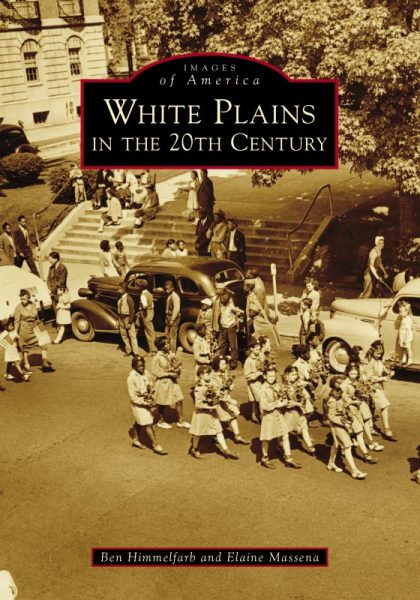New Book Details White Plains in the 20th Century

Former White Plains resident Ben Himmelfarb and current resident Elaine Massena worked in similar capacities in the city and would often cross paths in their jobs.
Massena is the city archivist with the city clerk’s office and Himmelfarb was the local history historian at the White Plains Library.
“We were always contacting each other because of research queries from the public,” Himmelfarb, who moved to Richmond, VA in February 2019, recalled last week. “Sometimes I could answer most of a person’s question, but would need a document or photograph that was in Elaine’s collection. Sometimes she needed something from the library’s collection. Elaine has been with the city longer than me so she was a direct source I could go to for leads on where to look in collections for information. While she, of course, does a great job with finding aids and cataloging her collection, she also has an immense amount of knowledge on file in her brain.”
Himmelfarb and Massena took their collaborations to another level by co-authoring “White Plains in the 20th Century,” which was recently published by Arcadia Publishing.
“Ben asked me to join him in writing this book for Arcadia Publishing and I was thrilled to do so,” Massena recalled. The photo collections from the library and the city’s archives include photographs taken by John Rosch, who was a photographer and city historian in the first half of the 20th Century and to whom the duo dedicated their book, along with Renoda Hoffman, Massena said.
Massena, a 35-year resident of White Plains, noted she had retired from the Westchester County archives in Elmsford, where she was the principal archivist. Massena was recruited in 1994 by the White Plains City Historian Renoda Hoffman to help her organize and house her extensive collection of White Plains materials, including thousands of slides she had taken beginning in the late 1950’s. Massena worked on a part-time basis with Hoffman from 1994 until her death in 2005. “She was the founder of the city archives and the guiding spirit in its growth,” Massena said. “Thanks to advances in technology, we have been able to digitize most of Renoda’s slides which document the changes in White Plains, as well as other collections in the archives. Some of the photos that we used in the book were taken by Renoda, such as the building of Route 287 through White Plains.”
Massena said most of the book’s photos are from the library or the city archives. “In a few circumstances we reached out to others for help,” Massena said. “One example was the images used to illustrate the fact that there were automobiles manufactured in White Plains, right on Mamaroneck Avenue. I tracked down some descendants of the Grossman family who graciously provided images for the book.”
Himmelfarb is currently the programming librarian at the Henrico County Public Library.
“For me, the research for the book happened organically during my four years at the White Plains Public Library,” Himmelfarb said. “Frankly, a good deal of the information presented in the book is the fruit of our labors answering questions for the public. For instance, on my own I don’t know if I would have come across pictures of Italian Americans in the early 20th Century, but a query from someone seeking information about the lives of their ancestors in White Plains led me to consult every source our collection had on the topic. Following that I fleshed out the stories behind the pictures featured in the first chapter of the book, some of the best pictures in there in my opinion.”
Himmelfarb said the book contains information compiled over the course of many years. The formal process of creating the book took about 18 months from conception to publishing, he noted.
Though much has changed over the decades in White Plains, immigration was a controversial subject even in the early part of the last century, Himmelfarb said. “There are almost always conflicts and tensions when new groups of people interact with each other, and the early 20th Century was notable for the anti-immigrant ideas aimed at people from Southern and Eastern Europe who were, at the time, the most recent arrivals to the US,” he said.
“On a positive note, like today, there were groups in White Plains (like the YMCA in the early 1900’s) that supported peaceful integration of new immigrants,” Himmelfarb said. “At the time, this meant a mix of assimilation and accommodation. Labor disputes between workers (often recent immigrants from Italy) and bosses over conditions at work sites around the county, especially the Kensico Dam and Reservoir, were common. The photographs in the book give a sense of the living conditions faced by many workers. Immigrants at the time were not just workers; some were landlords or business owners.”
Himmelfarb and Massena held an author event in November, but they do not have any plans for future in person events on the book since Himmelfarb no longer lives in the New York area. But Himmelfarb said he would be happy to do virtual presentations and talks about the book.
Himmelfarb said he would like to collaborate on another book with Massena. “I think we’ll give it a few years, but should we be around long enough we’ll probably do “White Plains in the 21st Century,” he said.
The book price is $21.99 and Himmelfarb said the best place to obtain it is at the White Plains Public Library or the city clerk’s office. All proceeds from the book are split evenly between the City Archives and the White Plains Collection for their maintenance and growth.
